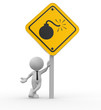The Key To Safe Driving For Life
On the road, let’s face it; we can do nothing about the actions of other drivers. We simply do not know what other drivers on the road are going to do. While driving, your safety lies mainly in your own hands. The better control you have of your vehicle and road space, the safer you’ll be.
What is defensive driving? It is a knowledge based safety mind set which allows the driver to see danger ahead and react accordingly. This reaction which normally is a reduction in speed will prevent a collision from occurring.
Defensive driving is probably the best way to ensure the safety of a driver and his or her passengers. Safe and Defensive Driving is not something you can inherit. It needs to be taught!
As a young inexperienced driver on the road it is vital you gain as much knowledge as possible to keep you safe during your first two years after passing your test.
This defensive driving checklist is here to keep your vehicle roadworthy and also to alert you to the skills and knowledge you must have to defuse any potentially dangerous situation developing on the road.
Knowledge Checks Here

- The increased risk of driving at night
- How to negotiate a bend correctly and safely
- Dealing with cornering forces and camber on a bend
- The correct method for overtaking
- When not to overtake
- Dealing with deteriorating weather conditions
- Stopping distance for different speeds in dry/wet and be able to relate these in practice
- Knowing the different elements which will increase your stopping distance
- Reading different road surfaces and their affect on tyre grip
- Being able to spot defective tyres
- Mind read other drivers actions and act accordingly if they cross your path
- Dealing with passenger distraction especially when driving at night
- Turning right at junctions
- Why extra vigilance is needed for the young and old
- Coping with motorcyclists
- Coping with cyclists
- Two second rule to stop tailgating
- Tyres on tarmac
Changing Weather Conditions Will Affect Your Braking Distance Considerably
Without experience in all weather conditions you as a learner driver must acquire the knowledge to deal with the following road and weather conditions which affect tyre grip and consequently you’re braking distance.
- The type and evenness of the road surface
- Soft tarmac/oil/loose chippings
- Hot weather and sun showers
- Wet surfaces
- Avoiding aquaplaning
- Floods
- Driving in Fog and correct use of lights
- Driving in Snow
- Driving in Ice
- Cornering/hills on ice and snow
- Crosswinds
- Know the clues to alert you to danger as the weather changes
Key point
The more of these variables present the greater will be your stopping distance. May even be more than your normal stopping distance.
Example: heavily loaded car with bad tracking, travelling downhill in hot weather after a sun shower coming into a hairpin bend. Every chance a driver without proper knowledge will skid in this situation. Don’t play Russian roulette; learn all the variables which can affect breaking distance. Remember this will also include the condition of your braking system.
Attitude Check
Good Attitude
- Learning to drive the car safely and considerably is classed an attitudinal skill because a good driver attitude leads to a safety conscious driver.
- Realize passing the driving test can give you a false sense of confidence; it is only the first step in your driving career. Only experience will help you become a safe driver.
Bad Attitude
People who do not care for the lives of their passengers or other road users, they will typically
- Ignore warning signs and slow pained on the road and do not reduce speed
- Overtake in dangerous situations near bends etc
- Speed into bends and consequently brake in the bend causing loss of control
- After passing driving test drive aggressively and consistently break the speed limit
- Drive competitively
Skill Checks
- Driver limitations
- Vehicle limitations
- Vehicle sympathy
- Instrumentation
- Correct/smooth use of controls
- Factors which affect vehicles breaking capacity
- Progressive braking
- Gear/speed ratios
- The power change
- Speed control
- Factors which will reduce tyre grip
- Dealing with skids
Click here for information on Student Deals
If you found any of the above information useful please share it by clicking on your favourite social media platfrom. We would really appreciate it, thank you.
